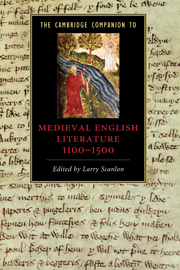Book contents
- Frontmatter
- Introduction
- Part I Contexts, genres, and traditions
- 1 Re-inventing the vernacular: Middle English language and its literature
- 2 Textual production and textual communities
- 3 Religious writing: hagiography, pastoralia, devotional and contemplative works
- 4 Romance
- 5 Dialogue, debate, and dream vision
- 6 Drama
- 7 Lyric
- 8 Lollard writings
- Part II Authors
- Guide to further reading
- Index
2 - Textual production and textual communities
from Part I - Contexts, genres, and traditions
Published online by Cambridge University Press: 28 November 2009
- Frontmatter
- Introduction
- Part I Contexts, genres, and traditions
- 1 Re-inventing the vernacular: Middle English language and its literature
- 2 Textual production and textual communities
- 3 Religious writing: hagiography, pastoralia, devotional and contemplative works
- 4 Romance
- 5 Dialogue, debate, and dream vision
- 6 Drama
- 7 Lyric
- 8 Lollard writings
- Part II Authors
- Guide to further reading
- Index
Summary
Some years ago, when I was teaching in eastern Canada, I attended a lecture, liberally illustrated with slides, given by a local sculptor on his recent visit to Japan. Unsurprisingly, in view of his vocation, he tended to dwell on monumental and architectural subjects rather than landscapes or human figures and for the best part of an hour we were invited to reflect upon the elegant simplicity of Japanese stone-carving and woodworking. At the end of the talk a slide of weathered wooden shingles silhouetted against a slate-gray sky appeared on the screen; it seemed to us a natural complement to the roof trusses and door jambs of the Shinto shrine we had just been contemplating, and we duly gazed at it with reverential awe. Just before the lecturer snapped the lights back on, he informed us that we were looking at the side of a cattle barn on Nova Scotia's Tantramar Marshes, not ten miles away from where we were sitting. All of us, I believe, experienced the same shock to our unreflective compartmentalization of the exotic and the familiar. It was, of course, a cheap trick, but it provided a vivid illustration of how readily we see what we expect to see, of how easily our eyes can be conditioned, or trained, or fooled into seeing only one aspect of a polysemous image.
In many ways it is the same with reading. One reader reads Bleak House because it's a good story, another because she enjoys the eccentric characters, a third because he is inspired by its social criticism - are all three, then, reading the same text? The answer of course must depend on how one defines “text,” but from the point of view of the reader-response theorist they would appear to be reading three closely related but nonetheless distinguishable Bleak Houses . What is of most interest to the reader-response theorist, however, is less the potentially limitless variety of such atomistic readings, but the common ground shared by larger groups of readers – what such readers will generally look to find in Dickens’s novel (their so-called “horizon of expectation”).
- Type
- Chapter
- Information
- Publisher: Cambridge University PressPrint publication year: 2009



